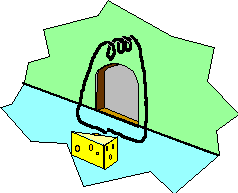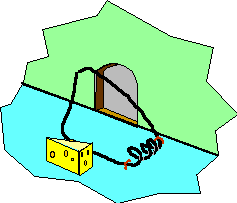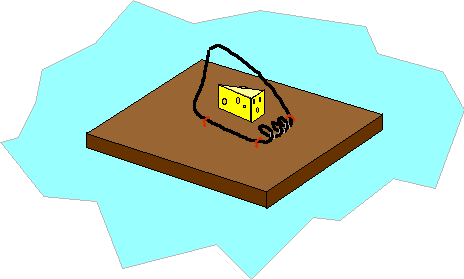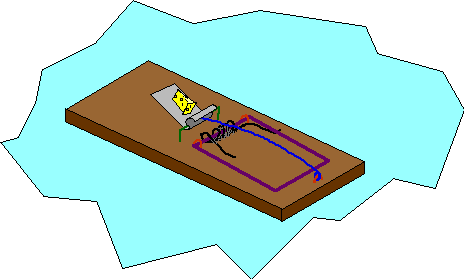A reducibly complex mousetrap
John H. McDonald
Department of Biological Sciences
University of Delaware
Creationist Michael Behe attracted a lot of attention with his advocacy of the “intelligent design” argument. He makes the claim that certain biochemical processes are “irreducibly complex”: they involve multiple proteins, and removing any one of them would destroy the function of the overall pathway. From this he concludes that these pathways could not have evolved through the action of natural selection, but instead must have been created by an “intelligent designer.”
To illustrate the concept of irreducibly complexity, Behe uses the common snap mousetrap. “If any one of the components of the mousetrap (the base, hammer, spring, catch, or holding bar) is removed, then the trap does not function. In other words, the simple little mousetrap has no ability to trap a mouse until several separate parts are all assembled. Because the mousetrap is necessarily composed of several parts, it is irreducibly complex.” (Behe, 1996).
It is not my purpose here to point out all of the philosophical flaws in Behe’s argument; this has been done thoroughly elsewhere (see Talk Origins and Talk Design to get started into the literature). Instead, I wish to point out that the mousetrap that Behe uses as an analogy CAN be reduced in complexity and still function as a mousetrap. The mousetrap illustrates one of the fundamental flaws in the intelligent design argument: the fact that one person can’t imagine something doesn’t mean it is impossible, it may just mean that the person has a limited imagination. Behe’s evidence that biochemical pathways are intelligently designed is that Behe can’t imagine how they could function without all of their parts, but given how easy it is to reduce the complexity of a mousetrap, I’m not convinced. (Of course, the reduced-complexity mousetraps shown below are intended to point out one of the logical flaws in the intelligent design argument; they’re not intended as an analogy of how evolution works.)
My original reduced-complexity mousetraps must have struck a nerve, since Behe later added a web page lengthy “rebuttal” of them to his webpage. I find his objections muddled and confusing, but he seems to be saying that showing how something would work after removing some parts is not enough to reject irreducible complexity; it is necessary to show how something could be built up, step by step, with each addition or modification of a part improving the function. This seems to go beyond the original definition (“necessarily composed of several parts”), but I have merely taken it as a challenge. Here I show how one could start with a single piece of spring wire, make an inefficient mousetrap, then through a series of modifications and additions of parts make better and better mousetraps, until the end result is the modern snap mousetrap. In addition to demonstrating that a mousetrap is not irreducibly complex, I also illustrate the most important objection to “irreducible complexity” as evidence for “intelligent design”: a part which may be optional at one stage of complexity may later become necessary due to modifications of some of the other parts.
A completely different series of mousetraps in various stages of complexity has been designed by Alex Fidelibus.
A recent article by Joachim Dagg (Dagg, J. 2011. Exploring mouse trap history. Evolution: Education and Outreach) reviews the history of actual mousetraps, showing that they did indeed “evolve” from simple to more complex through time, including mousetraps that were similar to the modern snap mousetrap but had fewer parts.
(This page has been translated into Romanian by Jan Rolsky, developer of a free mp4 converter).
(If the “Animate” buttons don’t make the pictures move, make sure your browser has Javascript enabled.)

I’ll start with a piece of springy wire, bent so that it can be held open by carefully positioning one end of the wire against the other. If an unlucky mouse steps on the trap and dislodges the ends, the trap closes. Most mice knock the trap over rather than sticking their necks through it, and the spring is so weak that some mice wriggle out before they die, so it’s not a very good trap. Still, it’s better than having no trap at all.

Adding a coil to the previous trap makes the trap close with more force. Every coil that is added makes the trap close with greater force, increasing the proportion of mice that get killed.

Adding bait makes the trap more efficient by attracting more mice to it. Bait is an optional part of all of the traps shown here; all of these traps would catch mice that happened to stumble into them.

The previous traps need to be carefully propped against a wall or other object, which limits the places they can be used and lets mice knock the trap over. Attaching the spring to the floor with one or two staples increases the usefulness of the trap, because it can now be used anywhere the floor is wooden, and mice won’t knock it over. The staples are optional at this point.

Attaching the spring to a piece of wood is even better, since it’s easier to move around, doesn’t leave holes in the floor, and can be used on concrete floors. The wooden platform and the staples are optional, though; the trap would still work with just the spring.

Making the swinging end of the wire (the “hammer”) longer increases the chance that it will hit a mouse, so as it gradually goes from I-shaped to L-shaped to U-shaped, it gradually becomes more effective. The free end of a U-shaped hammer might flex enough that it wouldn’t crush all mice; tucking it into the coils of the spring improves on this.

The previous trap had the hammer propped up on a vertical piece of wire. This must be done very precisely, so that a mouse brushing against the vertical piece of wire will dislodge the hammer. Adding another piece of wire as a hold-down bar makes it easier to set the trap and easier for a mouse to trip it. One end of the hold-down bar is jammed into the end of the wooden platform, while the other end is hooked under the corner of the hammer. When a mouse nudges the hold-down bar, dislodging it from the corner of the hammer, it releases the hammer. Because the hold-down bar is a lever, it holds the hammer down with much less force and therefore requires less force to dislodge.

The base of the previous trap will eventually get splintered where the hold-down bar is jammed into it. Using a staple to hold the end of the hold-down bar increases the useful life of the mousetrap.

With the hold-down bar in use, the vertical part of the spring wire is unnecessary and maybe even in the way. Shortening it saves wire, making the trap less costly. This modification has some dramatic side effects, though. Now the hold-down bar and the staples are necessary parts of the trap, rather than just optional improvements. Take away the hold-down bar or the staples, and this version of the trap would not catch any mice. This is an analogy for the way that an initially optional protein in a biochemical pathway later could become necessary to the function of the pathway, due to adaptative modification of other enzymes.

The previous traps have a lot of upward force on the leftmost staple, which might eventually work its way out. Eliminating that staple saves a little on the cost of the trap and may increase its useful life.

On the previous traps, the only mice that get caught are those that push the hold down bar outward; mice that push it in towards the spring fail to dislodge it. Resting the end of the hold-down bar under the top of a bent-over staple is better; now a mouse that pushes the bar in either direction will trigger the trap.

Spring wire is harder to work with than regular wire, and I’ll bet it’s more expensive, too. Using regular wire for the rectangular hammer and using spring wire only for the spring makes the trap a little cheaper and easier to build. This is an analogy for another way that a seemingly “irreducible” pathway could originate: a single protein that performs two functions could evolve into two proteins, each of which performs a single, necessary function.

The hold-down bar in the previous traps still required a fair-sized nudge to dislodge it from the bent-over staple. Hooking a clever little catch onto the staple makes it much easier to trigger the trap; any jiggle of the catch releases the hold-down bar, releasing the hammer, and killing the mouse.
Link collected : http://udel.edu/~mcdonald/mousetrap.html

